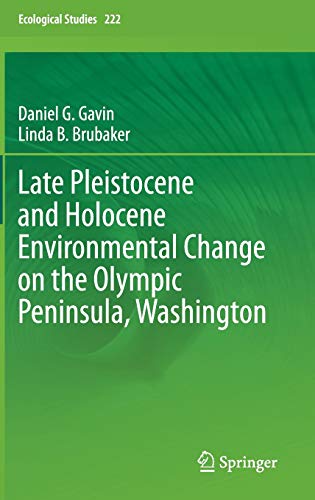Articoli correlati a Late Pleistocene and Holocene Environmental Change...
Late Pleistocene and Holocene Environmental Change on the Olympic Peninsula, Washington: 222 - Rilegato

Le informazioni nella sezione "Riassunto" possono far riferimento a edizioni diverse di questo titolo.
Utilizing a paleoecological approach, this volume brings together decades of research on the modern natural environment of Washington State’s Olympic Peninsula. This review of past research on paleoenvironmental change since the Late Pleistocene presents paleoecological records of changing forest composition and fire over the last 14,000 years. This volume, and its conclusions, draws extensively from Dr. Daniel Gavin and Dr. Linda Brubaker’s study of five Olympic Peninsula pollen records.
The Olympic Peninsula is an ideal setting for studying the responses of ecosystems to past climate change. Located just south of the maximum ice-sheet extent during the Last Glacial Maximum, there is abundant evidence that it functioned as a glacial refugium; 29 taxa endemic to the peninsula likely persisted in such refugia. Furthermore, its uniquely steep rainfall gradient produces a wide range of habitats over short distances. A literature review, synthesis of published data, and close examination of the authors’ investigations of post-glacial climate and vegetation change, this book features detailed color maps and data graphics.
Le informazioni nella sezione "Su questo libro" possono far riferimento a edizioni diverse di questo titolo.
- EditoreSpringer Nature
- Data di pubblicazione2014
- ISBN 10 3319110136
- ISBN 13 9783319110134
- RilegaturaCopertina rigida
- Numero di pagine142
Compra nuovo
Scopri di più su questo articolo
Spese di spedizione:
GRATIS
In U.S.A.
I migliori risultati di ricerca su AbeBooks
Late Pleistocene and Holocene Environmental Change on the Olympic Peninsula, Washington (Ecological Studies) [Hardcover ]
Descrizione libro Hardcover. Condizione: new. Codice articolo 9783319110134
Late Pleistocene and Holocene Environmental Change on the Olympic Peninsula, Washington (Ecological Studies, 222)
Descrizione libro Condizione: New. Codice articolo ABLIING23Mar3113020088472
Late Pleistocene and Holocene Environmental Change on the Olympic Peninsula, Washington
Descrizione libro Hardcover. Condizione: Brand New. 2015 edition. 142 pages. 9.25x6.25x0.75 inches. This item is printed on demand. Codice articolo zk3319110136
Late Pleistocene and Holocene Environmental Change on the Olympic Peninsula; Washington
Print on DemandDescrizione libro Condizione: New. PRINT ON DEMAND Book; New; Fast Shipping from the UK. No. book. Codice articolo ria9783319110134_lsuk
Late Pleistocene and Holocene Environmental Change on the Olympic Peninsula, Washington
Descrizione libro Buch. Condizione: Neu. This item is printed on demand - it takes 3-4 days longer - Neuware -This study brings together decades of research on the modern natural environment of Washington's Olympic Peninsula, reviews past research on paleoenvironmental change since the Late Pleistocene, and finally presents paleoecological records of changing forest composition and fire over the last 14,000 years. The focus of this study is on the authors' studies of five pollen records from the Olympic Peninsula. Maps and other data graphics are used extensively. Paleoecology can effectively address some of these challenges we face in understanding the biotic response to climate change and other agents of change in ecosystems. First, species responses to climate change are mediated by changing disturbance regimes. Second, biotic hotspots today suggest a long-term maintenance of diversity in an area, and researchers approach the maintenance of diversity from a wide range and angles (CITE). Mountain regions may maintain biodiversity through significant climate change in 'refugia': locations where components of diversity retreat to and expand from during periods of unfavorable climate (Keppel et al., 2012). Paleoecological studies can describe the context for which biodiversity persisted through time climate refugia. Third, the paleoecological approach is especially suited for long-lived organisms. For example, a tree species that may typically reach reproductive sizes only after 50 years and remain fertile for 300 years, will experience only 30 to 200 generations since colonizing a location after Holocene warming about 11,000 years ago. Thus, by summarizing community change through multiple generations and natural disturbance events, paleoecological studies can examine the resilience of ecosystems to disturbances in the past, showing how many ecosystems recover quickly while others may not (Willis et al., 2010). 156 pp. Englisch. Codice articolo 9783319110134
Late Pleistocene and Holocene Environmental Change on the Olympic Peninsula, Washington
Descrizione libro Gebunden. Condizione: New. Codice articolo 4498919
Late Pleistocene and Holocene Environmental Change on the Olympic Peninsula, Washington
Descrizione libro Buch. Condizione: Neu. Druck auf Anfrage Neuware - Printed after ordering - This study brings together decades of research on the modern natural environment of Washington's Olympic Peninsula, reviews past research on paleoenvironmental change since the Late Pleistocene, and finally presents paleoecological records of changing forest composition and fire over the last 14,000 years. The focus of this study is on the authors' studies of five pollen records from the Olympic Peninsula. Maps and other data graphics are used extensively. Paleoecology can effectively address some of these challenges we face in understanding the biotic response to climate change and other agents of change in ecosystems. First, species responses to climate change are mediated by changing disturbance regimes. Second, biotic hotspots today suggest a long-term maintenance of diversity in an area, and researchers approach the maintenance of diversity from a wide range and angles (CITE). Mountain regions may maintain biodiversity through significant climate change in 'refugia': locations where components of diversity retreat to and expand from during periods of unfavorable climate (Keppel et al., 2012). Paleoecological studies can describe the context for which biodiversity persisted through time climate refugia. Third, the paleoecological approach is especially suited for long-lived organisms. For example, a tree species that may typically reach reproductive sizes only after 50 years and remain fertile for 300 years, will experience only 30 to 200 generations since colonizing a location after Holocene warming about 11,000 years ago. Thus, by summarizing community change through multiple generations and natural disturbance events, paleoecological studies can examine the resilience of ecosystems to disturbances in the past, showing how many ecosystems recover quickly while others may not (Willis et al., 2010). Codice articolo 9783319110134

